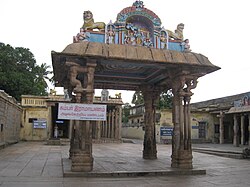This articleneeds additional citations forverification.(February 2018) |
TheRamavataram,popularly referred to asKamba Ramayanam,is aTamilepicthat was written by theTamilpoetKambarduring the 12th century. Based onValmiki'sRamayana(which is inSanskrit), the story describes the legend of KingRamaofAyodhya.However, theRamavataramis different from theSanskritversion in many aspects – both in spiritual concepts and in the specifics of the storyline.[1][2]This historic work is considered by both Tamilscholarsand the general public as one of the greatest literary works inTamil literature.[3]


Kambar wrote this epic with thepatronageofThiruvennai Nallur Sadayappa Vallal,a chieftain of the Pannai lineage.[4]In gratitude to his patron, Kamban references his name once in every 1,000verses.
Early references in Tamil literature
editEven before Kambar wrote the Ramavataram in Tamil in the 12 century CE, there are many ancient references to the story of Ramayana, implying that the story was familiar in the Tamil lands even before the Common Era. References to the story can be found in theSangam literatureofAkanaṉūṟu,(dated 200 BCE–300 CE)[5]andPurananuru(dated 200 BCE–300 CE),[6][7]the twin epics ofSilappatikaram(dated 6th century CE)[8]andManimekalai,[9][10][11]and theAlvarliterature ofKulasekhara Alvar,Thirumangai Alvar,AndalandNammalvar(dated between 8th and 10th centuries CE).[12]
Structure
editThe book is divided into six chapters, calledKandamin Tamil. The Kandams are further divided into 113 sections calledPadalam(படலம்) in Tamil. These 113 sections contain approximately 10569 verses of the epic.[13]
Compilation
editAs with many historic compilations, it was very difficult to discard the interpolations and addendum which have been added over a period of time to the original. This task was taken up a committee of scholars headed byT. P. Meenakshisundaramcalled theKamban Kazhagam(Kamban Academy). The compilation published by this committee in 1976 is what is used as the standard today.Valmiki'sRamayanain Sanskrit has seven chapters. The Tamil poetOttakoothar[16]wroteUttara Kandam,the seventh (last chapter) kandam of the Tamil epicRamayanam.
Literary significance
editKamban's use of Virutham (Sanskrit: vṛttam) and Santham (Sanskrit:chandas) in various verses is effective in bringing out the emotion and mood for storytelling. He achieves the Virutham and Santham by effective choice of words.[citation needed]
Religious significance
editThis epic is read by many Hindus during prayers. In some households, the entire epic is read once during theTamil calendar's month of Aadi (mid-July to mid-August). It is also read inHindu Templesand other religious associations. On many occasions, Kambar talks about surrendering to Rama, who is a manifestation ofVishnuhimself.[citation needed]
The chapterSundara Kandamis considered very auspicious and is the most popular. The chapter talks about the hardships faced by the main characters in the epic, their practice of restraint, and their hopes for a better tomorrow.[citation needed]
Translations
editKamba Ramayanam has been translated into English byP. S. Sundaram.[17]Nityananda Mohapatratranslated the Tamil work intoOdia.[18]: 214
See also
editReferences
edit- ^P S Sundaram (3 May 2002).Kamba Ramayana.Penguin Books Limited. pp. 18–.ISBN978-93-5118-100-2.
- ^Aiyar, V V S (1950).Kamba Ramayanam - A Study with translations in verse or poetic prose of over four thousand of the original poems.Parliament Street, New Delhi: Delhi Tamil Sangam.Retrieved18 June2019.
- ^"Focus on Kamban, poet extraordinaire".The Hindu.23 May 2010.Retrieved8 February2018.
- ^Alexander's Lesson and Other Stories.Sura Books. 2006. pp. 44–.ISBN978-81-7478-807-8.
- ^Dakshinamurthy, A (July 2015)."Akananuru: Neytal – Poem 70".Akananuru.Retrieved22 July2019.
- ^Hart, George L; Heifetz, Hank (1999).The four hundred songs of war and wisdom: an anthology of poems from classical Tamil: the Puṟanāṉūṟu.Columbia University Press.ISBN978-0-231-11562-9.
- ^Kalakam, Turaicămip Pillai, ed. (1950).Purananuru.Madras.
{{cite book}}:CS1 maint: location missing publisher (link) - ^Dikshitar, V R Ramachandra (1939).The Silappadikaram.Madras, British India: Oxford University Press.Retrieved22 July2019.
- ^Pandian, Pichai Pillai (1931).Cattanar's Manimekalai.Madras: Saiva Siddhanta Works.Retrieved30 July2019.
- ^Aiyangar, Rao Bahadur Krishnaswami (1927).Manimekhalai In Its Historical Setting.London: Luzac & Co.Retrieved30 July2019.
- ^Shattan, Merchant-Prince (1989). Daniélou, Alain (ed.).Manimekhalai: The Dancer With the Magic Bowl.New York: New Directions.
- ^Hooper, John Stirling Morley (1929).Hymns of the Alvars.Calcutta: Oxford University Press.Retrieved30 July2019.
- ^Sujit Mukherjee (1998).A Dictionary of Indian Literature: Beginnings-1850.Orient Blackswan. p. 162.ISBN978-81-250-1453-9.
- ^Mudaliyar, V S (1970).Kamba Ramayanam - A condensed version in English verse and prose.New Delhi: Ministry of Education and Youth Services, Government of India.Retrieved18 June2019.
- ^Hart, George L; Heifetz, Hank (1988).The Forest Book of the Ramayana of Kampan.Berkerley, United States: University of California Press.ISBN9780520060883.
- ^The seventh kandam, (last chapter)Uttara Kandamof the Tamil epicRamayanamwas written by Ottakoothar.Tamil Ramayana's Uttara Kandam: page 59Tamil Virtual University. Retrieved 26 April 2022.
- ^N. S. Jagannathan, ed. (2002).Kamba Ramayana.Gurgaon: Penguin Books. p. vii–x.ISBN978-01-430281-5-4.
- ^Panda, Aditya Kumar (2015)."Translation in Odia: A Historical Survey"(PDF).Translation Today.9(1). National Translation Mission: 202–226.Retrieved4 January2024.
External links
edit- Tamil Virtual University: Kamba Ramayanam
- Tamil literature repository: Kamba Ramayanam atProject Madurai